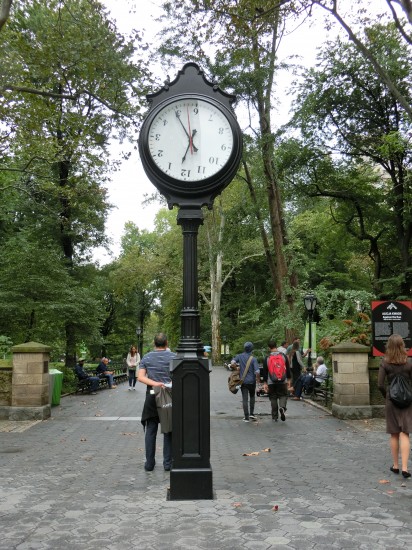
Alicja Kwade’s “Against the Run” offers a unique view of time at entrance to Central Park (photo by twi-ny/mdr)
Scholars’ Gate, Doris C. Freedman Plaza
Central Park entrance, 60th St. & Fifth Ave.
Through February 14, free
publicartfund.org
against the run slideshow
“I’m late! I’m late! For a very important date! No time to say hello, goodbye! I’m late! I’m late! I’m late!” the White Rabbit, checking his pocket watch, declares in Walt Disney’s Alice in Wonderland animated movie. If you don’t act fast, you’ll be too late to catch visual artist Alicja Kwade’s first solo public project in America, “Against the Run,” which will be on view through Valentine’s Day on Doris C. Freedman Plaza at the Sixtieth St. entrance to Central Park at Fifth Ave. In her 2006 video Ein Tag in 7 Minuten und 23 Sekunden, the Berlin-based Polish artist showed the progression of one day through a series of existing film clips of all kinds of clocks — four years before Christian Marclay debuted his twenty-four-hour installation, The Clock. Kwade often focuses on complex issues of time, space, and light while using found, ready-made objects (clocks, lamps, and mirrors are among her favorites) and tweaking them to turn them into something new. In the Public Art Fund group exhibition “Lightness of Being” two years ago in City Hall Park, Kwade, who has won the prestigious Piepenbrock Prize for Sculpture and the Hector Prize, contributed “Journey without Arrival (Raleigh),” a bicycle that seemed to have gone through a rather rough trip. For “Against the Run,” also for the Public Art Fund, Kwade has taken a classic nineteenth-century-style city street clock and played around with the internal mechanisms so that the face runs counterclockwise and the hands appear to be standing still. Nevertheless, the clock is always telling the correct time, even if it appears to be crooked and running backward. It forces you to stop and take some extra moments to understand what’s going on, offering a much-needed contemplative respite from the crazy busyness of now, especially in this overcrowded part of Midtown. As she has done so often, Kwade, who cites as influences such luminaries as Marcel Duchamp, Harry Houdini, Robert Smithson, and Gordon Matta-Clark, has given us a new reality that is really no different from our regular reality, just slightly askew, as if you’ve fallen down that rabbit hole and can’t quite get out.